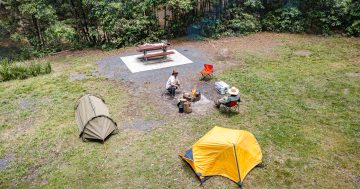
Famous as the world water speed record site in 1978, Blowering Dam is one of the biggest dams in NSW. Photo: Forestry NSW.
It took 28 months to turn the corner but from today cars can return to the southern end of Blowering Dam, just in time for Easter.
From Thursday (14 April) visitors and residents can also access between Batlow and Talbingo, Forestry NSW stewardship and fire manager Charlie Taylor said.
Millions of dollars have been spent repatriating the popular recreational reserve after it was annihilated by its two greatest adversaries; bushfires in the summer of 2019/20 and massive amounts of rainfall over the following two years.
Forestry Corporation’s Snowy Region manager Dean Anderson said the scale of infrastructure damage had been unprecedented. More than 170 km of damaged roads needed repair in the state forest next to Blowering Dam alone.
“This is longer than the road trip from Tumut to Gunning,” he said.
Mr Anderson said that in the 1960s when the then Forestry Commission of NSW was asked to establish pine plantations to help protect the Blowering catchment, more than 60 dams were built to reduce silt and soil entering the Blowering Dam.
“During the Black Summer fires these dams did the job they were designed to do and captured a lot of the silt coming off the bare hills,” he said.

In the two years since the Black Summer bushfires more than 170 km of damaged roads have needed repairs in the state forest next to Blowering Dam alone. Photo: Forestry NSW.
But remediating the network of silt dams remained one of Forestry Corporation’s main priorities. Engineers and soil specialists were engaged to assess each dam to reduce the amount of sediment making its way into the Blowering Dam.
Annual pasture grasses were sown by air to provide some initial groundcover until the dead trees could be removed and a new pine plantation established.
“We are very pleased to be able to reopen Yellowin Road and foreshore roads, between Batlow, Blowering Dam and Talbingo, for public access,” Mr Taylor said.
The many months of ongoing wet weather had seen landslips, culvert washouts and collapsing sections of roadway continue since the Black Summer bushfires, but a recent dry spell allowed the completion of repairs.
Many minor fire trails on the southern end of Blowering Dam remain impassable to vehicles and Mr Taylor warned the public should keep to main roads.
“People will still need to drive through these areas with caution, as there are a lot of blind corners, and branches may drop from fire-damaged trees,” he said.
“We have established a 40 km-per-hour speed limit for Yellowin Road; please adhere to this limit for your safety and that of others on the road.”
The pine forest with dead and burnt trees on the western side of Blowering Dam will remain closed to public access for the foreseeable future.
There’s more good news ahead of Easter, with solid fuel fire bans already lifted in pine forests around Tumut and Tumbarumba.
Adventurers across the Riverina will now be able to light campfires and barbecues using wood, charcoal or other solid fuel, with the solid fuel fire bans in the redgum and southern cypress state forests being lifted from midnight tomorrow.
Forestry Corporation of NSW’s district manager Andrew McCurdy said solid fuel fires had been banned to help protect against bushfires.
“While the high fire danger period has passed, we urge all campers to exercise common sense and remain vigilant when lighting and using fires in the forest,” Mr McCurdy said.
“Please use properly constructed fireplaces, sweep away all leaves grasses and other flammable material around the fireplace before lighting a campfire and make sure your campfire is completely extinguished before leaving the forest,” he added.
“Remember to put safety first and never leave a campfire unattended.”
The solid fuel fire bans will be lifted from midnight on 14 April 2022 in the Koondrook, Perricoota and Campbells Island State Forests along the Murray, the Gillenbah, Buckingbong, Matong and Binya State forests in the Murrumbidgee catchment and smaller cypress forests.









